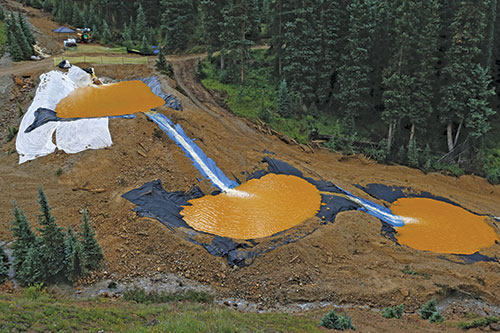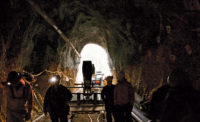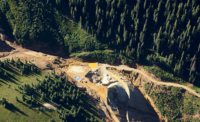

State and tribal officials in Colorado and New Mexico have reopened the Animas and San Juan rivers since an accidental 3-million-gal toxic spill from an abandoned mine on Aug. 5. Officials, contractors and others are debating the incident’s cause and long-term effects.
Working upstream on reclamation of an abandoned mine in Silverton, Colo., an equipment operator employed by Environmental Restoration LLC, a Fenton, Mo.-based contractor for the U.S. Environmental Protection Agency, may have unleashed the mine waste into the Animas River while using an excavator to unseal a collapsed mine shaft. However, incorrect geotechnical information or changed ground conditions may also be factors.
Environmental Restoration is a major EPA contractor, based on contract information in the Federal Procurement Data System. The 445-employee firm ranks at No. 82 on ENR’s list of the Top 200 Environmental Firms, reporting $91.7 million in 2014 revenue (ENR 8/10-8/17 p. 72). The firm’s website touts its expertise in high-profile disaster cleanup work, including the 2010 Deepwater Horizon spill in the Gulf of Mexico and the TransCanada pipeline spill in Michigan’s Kalamazoo River. The firm referred inquiries to EPA.
The spill from the Gold King Mine turned the river bright orange for several days as the mine plume flowed downstream. Officials quickly moved to close the downstream sections of the Animas and San Juan to recreational use. Several reservoirs and irrigation districts ceased drawing water in areas of Colorado, Utah and New Mexico. The Animas Aug. 14 reopening followed sampling and testing, which showed the river had returned to “pre-spill” conditions, EPA said. Still unclear is whether construction of bulkheads at a nearby mine led to flow buildup at Gold King, where the mishap occurred.
Environmental hazards from abandoned mines are becoming a bigger EPA priority, often forcing it to take the lead to manage what the Center for Biological Diversity calls a “legacy of pollution.” Taylor MacKinnon, a spokesman for the environmental group, says, “While the EPA triggered this particular release, the pollution was caused by the mining industry.” The federal effort was accelerated last year in the $5.1-billion settlement with Anadarko Petroleum Corp., which assumed liability to clean up hundreds of abandoned mines once owned by its Kerr-McGee unit.
Flowing through the once metals-rich San Juan Mountains, the Animas River is a destination for wildlife and fishing enthusiasts that has been affected often by toxic mining waste from some 400 abandoned mines in the river basin, says Peter Butler, director of the Animas River stakeholders’ group, whose members are mining firms and area activists. About 60 mines need reclamation work, he says.
In May, EPA announced it would launch a “time critical” effort to plug the Gold King and other nearby mines that had been leaking metallic water into Animas tributaries. Flows from the closed mines increased in recent years, and EPA said in an April report that higher levels of some metals followed the plugging of another area mine—Sunnyside Gold, owned by Kinross Gold Corp. a Canadian company.
EPA says that, between 1996 and 2002, Gold King and two other mines experienced significant increases in flow following construction at the Sunnyside Mine-American Tunnel site. Sunnyside was allowed to seal its mine and walk away, claims Gold King owner Todd Hennis. His assessment could not be verified by press time.
Outdated laws also obscure who has legal responsibility for mitigating waste risks from abandoned mines, says K.K. DuVivier, a geologist and mining law expert at the University of Denver. She says U.S. mining laws have not changed much since 1872, and many individuals and companies that founded and operated the mines are long gone.
One of the biggest problems is that “Good Samaritans” who do mine cleanup work are afraid of liability. “That’s why EPA itself has ended up doing the work,” DuVivier says.




Post a comment to this article
Report Abusive Comment